How To Create Defined Names In Excel
The tutorial explains what an Excel proper name is and shows how to define a proper name for a cell, range, abiding or formula. You volition as well acquire how to edit, filter and delete defined names in Excel.
Names in Excel are a paradoxical thing: being one of the most useful features, they are oft considered pointless or nerdy. The reason is that very few users understand the essence of Excel names. This tutorial will non only teach yous how to create a named range in Excel, but will also show how to leverage this feature to make your formulas much easier to write, read, and re-employ.
What does proper noun hateful in Excel?
In everyday life names are widely used to refer to people, objects and geographical locations. For example, instead of saying "the city lying at breadth 40.7128° N and longitude 74.0059° W, y'all simply say "New York City".
Similarly, in Microsoft Excel, you tin can give a human-readable name to a single cell or a range of cells, and refer to those cells past name rather than by reference.
For case, to find the full of sales (B2:B10) for a specific item (E1), yous can use the following formula:
=SUMIF($A$two:$A$10, $E$one, $B$2:$B$x)
Or, yous can give meaningful names to the ranges and individual cells and supply those names to the formula:
=SUMIF(items_list, item, sales)
Looking at the screenshot below, which of the two formulas are easier for y'all to sympathise?
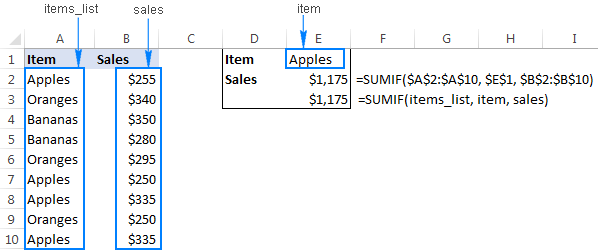
Excel name types
In Microsoft Excel, you can create and use two types of names:
Defined name - a name that refers to a single cell, range of cells, constant value, or formula. For example, when you ascertain a name for a range of cells, it's called a named range, or defined range. These names are subject field of today's tutorial.
Tabular array name - a proper name of an Excel table that is created automatically when you insert a table in a worksheet (Ctrl + T). For more information about Excel tables, please see How to make and utilise a table in Excel.
How to create an Excel named range
Overall, there are 3 ways to ascertain a name in Excel: Name Box, Ascertain Name button, and Excel Name Manager.
Blazon a proper noun in the Name Box
The Name Box in Excel is fastest way to create a named range:
- Select a prison cell or a range of cells that you want to name.
- Type a name into the Name Box.
- Press the Enter key.
Voila, a new Excel named range is created!

Create a proper noun by using the Define Name option
Another style to brand a named range in Excel is this:
- Select the cell(s).
- On the Formulas tab, in the Define Names grouping, click the Define Name button.
- In the New Name dialog box, specify iii things:
- In the Name box, blazon the range name.
- In the Telescopic dropdown, fix the name scope (Workbook by default).
- In the Refers to box, check the reference and correct it if needed.
- Click OK to save the changes and close the dialog box.
Notation. Past default, Excel creates a name with absolute references. If yous'd rather accept a relative named range, remove the $ sign from the reference (before you practice this, make sure yous fully sympathize how relative names behave in worksheets).
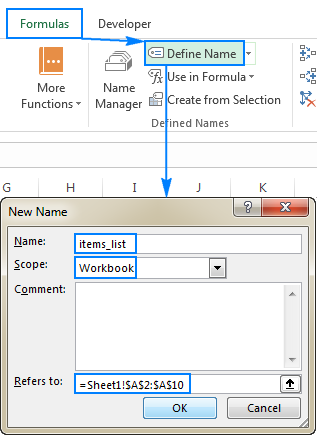
Compared to the previous method, using Define Name in Excel takes a few actress clicks, simply it also provides a couple more options such every bit setting the name's scope and adding a annotate that explains something nigh the name. Additionally, Excel's Define Proper noun feature allows you to create a name for a constant or formula.
Make a named range past using Excel Name Director
Usually, the Name Director in Excel is used to work with existing names. However, it can help you build a new name too. Here's how:
- Get to the Formulas tab > Defined Names group, click Name Manager. Or, just press Ctrl + F3 (my preferred style).
- In the top left mitt corner of the Proper name Manager dialog window, click the New… button:

- This volition open the New Name dialog box where you lot configure a name as demonstrated in the previous section.
Tip. To quickly test the newly created name, select it in the Proper name Box dropdown list. As before long every bit you release the mouse, the range on the worksheet volition exist selected.
How to create an Excel proper noun for a constant
In addition to named ranges, Microsoft Excel allows you to define a name without cell reference that volition piece of work as a named constant. To create such a name, utilize either the Excel Define Proper name feature or Name Director as explained above.
For instance, you tin can make a name like USD_EUR (USD - EUR conversion rate) and assign a fixed value to it. For this, type the value preceded past an equal sign (=) in the Refers to field, e.g. =0.93:

And now, you can use this proper name anywhere in your formulas to catechumen USD to EUR:

As shortly every bit the substitution rate changes, you lot update the value only in 1 fundamental location, and all of your formulas volition get recalculated in a single step!
How to define a name for a formula
In a similar way, you can give a name to an Excel formula, for instance, the one that returns the count of not-empty cells in column A, excluding the header row (-1):
=COUNTA(Sheet5!$A:$A)-ane
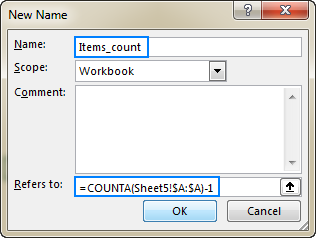
Note. If your formula refers to any cells on the current canvass, yous do not need to include the canvass proper name in the references, Excel will exercise it for y'all automatically. If you are referencing a cell or range on another worksheet, add together the sheet's proper name followed by the exclamation indicate before the cell/range reference (similar in the formula example in a higher place).
Now, whenever you want to know how many items at that place are in cavalcade A on Sheet5, not including the cavalcade header, merely type the equality sign followed by the name of your formula in any cell, like this: =Items_count

How to proper name columns in Excel (names from pick)
If your data is arranged in a tabular form, you can rapidly create names for each column and/or row based on their labels:
- Select the entire table including the column and row headers.
- Go to the Formulas tab > Define Names group, and click the Create from Option push button. Or, printing the keyboard shortcut Ctrl + Shift + F3.
- Either fashion, the Create Names from Selection dialogue box will open. You select the column or row with headers, or both, and click OK.
In this example, we have headers in the top row and left column, and then we select these two options:
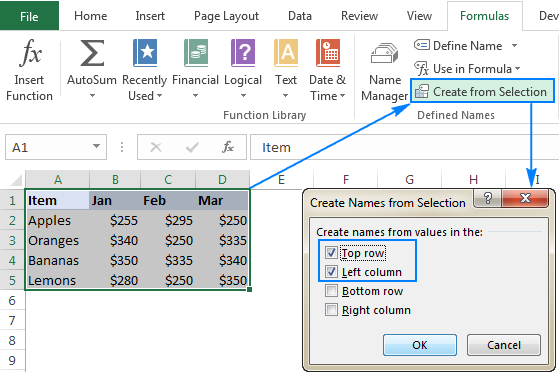
Equally the result, Excel will create seven named ranges, picking up names from the headers automatically:
- Apples, Bananas, Lemons and Oranges for rows, and
- Jan, February and Mar for columns.

Note. If there are whatsoever spaces between words in the header labels, the spaces will be replaced with underscores (_).
Excel dynamic named range
In all previous examples, we have been dealing with static named ranges that e'er refer to the aforementioned cells, meaning you would have to update the range reference manually whenever yous want to add new data to the named range.
If you are working with expandable data sets, information technology stands to reason to create a dynamic named range that accommodates newly added data automatically.
The detailed guidance on how to create a dynamic named range in Excel tin can exist found hither:
Excel naming rules
When creating a name in Excel, there are a few rules to recall:
- An Excel proper name should be under 255 characters long.
- Excel names cannot contain spaces and near punctuation characters.
- A name must begin with a letter, underscore (_), or backslash (\). If a name begins with anything else, Excel volition throw an error.
- Excel names are case-insensitive. For instance, "Apples", "apples" and "APPLES" volition be treated as the same name.
- Yous cannot name ranges like cell references. That is, you can't give the name "A1" or "AA1" to a range.
- Y'all can use a single letter to name a range like "a", "b", "D", etc. except for the letters "r" "R", "c", and "C" (these characters are used as shortcuts for selecting a row or cavalcade for the currently selected cell when y'all blazon them in the Name Box).
Excel proper noun scope
In terms of Excel names, telescopic is the location, or level, within which the name is recognized. It can be either:
- Specific worksheet - the local worksheet level
- Workbook - the global workbook level
Worksheet level names
A worksheet-level proper name is recognized within the worksheet where information technology is located. For example, if yous create a named range and set its telescopic to Sheet1, information technology volition exist recognized just in Sheet1.
To be able to use a worksheet-level name in another worksheet, you must prefix the worksheet'due south proper noun followed past the assertion bespeak (!), like this:
Sheet1!items_list
To reference a worksheet-level proper name in another workbook, you lot should also include the workbook name enclosed in square brackets:
[Sales.xlsx]Sheet1!items_list
If either the sheet name or workbook proper noun contains spaces, they should be enclosed in unmarried quotation marks:
'[Sales 2017.xlsx]Sheet1'!items_list
Workbook level names
A workbook-level name is recognized within the entire workbook, and you can refer to information technology simply by name from any sheet in the same workbook.
A use to a workbook-level name in some other workbook, precede the name with the workbook proper noun (including the extension) followed by the exclamation indicate:
Book1.xlsx!items_list
Scope precedence
A divers name must be unique inside its scope. You can utilise the aforementioned proper noun in different scopes, merely this might create a proper noun conflict. To prevent this from happening, by default, the worksheet level takes precedence over the workbook level.
If there are a few identically named ranges with different scopes, and you want to use the workbook level proper noun, prefix the name with the workbook name as if you were referring to a proper noun in another workbook, e.thousand.: Book1.xlsx!information. This way, the name disharmonize can exist overridden for all worksheets except for the first sheet, which e'er uses the local worksheet level proper name.
Excel Proper noun Manager - quick style to edit, delete and filter names
As its name suggests, the Excel Name Managing director is peculiarly designed to manage names: change, filter, or delete existing names as well as create new ones.
There are ii ways to get to the Proper name Manager in Excel:
- On the Formulas tab, in the Define Names group, click the Name Director
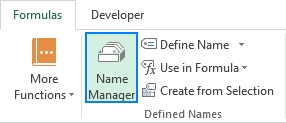
- Press the Ctrl + F3 shortcut.
Either way, the Name Manager dialog window will open, letting you see all names in the current workbook at a glance. Now, you tin select the proper name you want to work with, and click one of the 3 buttons at the pinnacle of the window to perform the corresponding activity: edit, delete or filter.
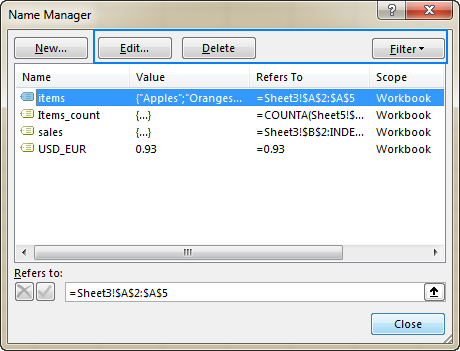
How to edit named range in Excel
To change an existing Excel proper noun, open up the Name Manager, select the name, and click the Edit… button. This will open up the Edit Proper name dialog box where you lot can change the name and reference. The scope of the proper name cannot be inverse.
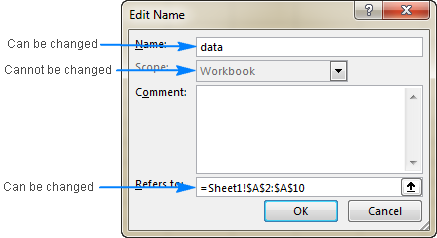
To edit a name reference, you practice not need to open the Edit Name dialog box. Simply select the name of interest in the Excel Name Managing director, and type a new reference directly in the Refers to box, or click the push at the right and select the desired range on the sail. After you click the Close button, Excel volition ask if you want to save the changes, and you lot click Yes.
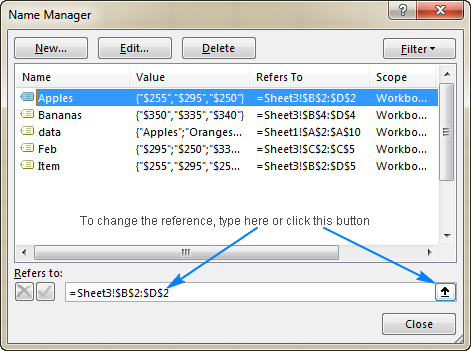
Tip. An attempt to navigate through a long reference or formula in the Refers to field with the arrow keys will nigh likely result in a very frustrating beliefs. To motility within this field without disrupting the reference, press the F2 key to switch from Enter to Edit mode.
How to filter names in Excel
If you have a lot of names in a certain workbook, click the Filter button at the top right corner of the Excel Name Manager window to view only the names relevant at a given time. The following filters are available:
- Names scoped to worksheet or workbook
- Names with or without errors
- Defined names or table names
How to delete named range in Excel
To delete a named range, select information technology in the Proper name Manager and click the Delete push button at the top.
To delete several names, click the beginning proper name, and then printing the Ctrl key and hold it while clicking other names you want to remove. Then click the Delete push button, and all selected names volition be deleted in one become.
To delete all divers names in a workbook, select the first name in the list, press and hold the Shift central, so click the terminal name. Release the Shift key and click Delete.
How to delete defined names with errors
If you lot take a number of invalid names with reference errors, click the Filter button > Names with Errors to filter them:

After that, select all filtered names as explained above (past using the Shift key), and click the Delete button.
Note. If any of your Excel names are used in formulas, be sure to update the formulas earlier deleting names, otherwise your formulas will render #NAME? errors.
Top 5 benefits of using names in Excel
So far in this tutorial, we have been focusing more often than not on how-to things that cover different aspects of creating and using named ranges in Excel. Simply you may be curious to know what is then special about Excel names that makes them worth the effort? The elevation five advantages of using defined names in Excel follow below.
i. Excel names make formulas easier to make and read
You don't accept to blazon complex references or go back and forth selecting ranges on the canvas. Merely starting time typing the name you want to employ in the formula, and Excel will show a list of matching names for you to cull from. Double click the desired name, and Excel will insert it in the formula straight away:

2. Excel names let creating expandable formulas
Past using dynamic named ranges, you tin can create a "dynamic" formula that automatically includes new data in calculations without you having to update every reference manually.
3. Excel names make formulas easier to re-use
Excel names go far a lot easier to re-create a formula to some other sheet or port a formula into a unlike workbook. All you have to exercise is create the aforementioned names in the destination workbook, copy/paste the formula as is, and yous will go information technology working immediately.
Tip. To prevent Excel form creating new names on the fly, copy the formula equally text in the formula bar instead of copying the formula cell.
4. Named ranges simplify navigation
To quickly get to a specific named range, just click on its proper noun in the Name box. If a named range resides on another sail, Excel volition have you to that canvas automatically.

Note. Dynamic named ranges do not show upwardly in the Name box in Excel. To come across dynamic ranges, open the Excel Name Director (Ctrl + F3) that shows full details nigh all names in the workbook, including their scope and references.
5. Named ranges allow creating dynamic driblet-downwardly lists
To build an expandable and updatable drop down listing, brand a dynamic named range first, and and so create a data validation list based on that range. The detailed step-by-stride instructions can be found here: How to create a dynamic dropdown in Excel.
Excel named range - tips and tricks
At present that you lot know the nuts of creating and using names in Excel, let me share a few more tips that may prove helpful in your work.
How to get a list of all names in the workbook
To get a more tangible list of all names in a electric current workbook, practice the following:
- Select the topmost prison cell of the range where you want the names to appear.
- Go to the Formulas tab > Ascertain Names grouping, click Apply in Formulas, and and so click Paste Names… Or, simply press the F3 key.
- In the Paste Names dialog box, click Paste Listing.

This will insert all Excel names along with their references in the current worksheet, commencement in the selected cell.
Absolute Excel names vs. relative Excel names
By default, Excel names behave similar absolute references - locked to specific cells. Even so, it is possible to make a named range relative to the position of the active cell at the time the proper name is divers. Relative names behave similar relative references - get changed when the formula is moved or copied to some other prison cell.
In fact, I cannot think of any reason why one would want to brand a relative named range, except maybe when a range consists of a single prison cell. Every bit an example, let'southward create a relative name that refers to a jail cell 1 column to the left of the current cell, in the same row:
- Select cell B1.
- Press Ctrl + F3 to open Excel Proper name Manager, and click the New…
- In the Proper name box, blazon the desired name, say, item_left.
- In the Refers to box, type
=A1. - Click OK.
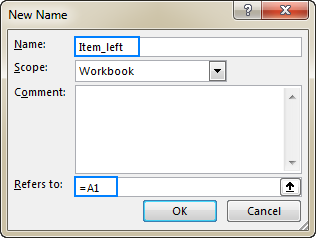
Now, permit's see what happens when we use the item_left name in a formula, for instance:
=SUMIF(items_list, item_left, sales)
Where items_list refers to $A$2:$A$ten and sales refers to $B$2:$B$x in the table beneath.
When you lot enter the formula in cell E2, and and then copy information technology down the column, information technology will calculate the total sales for each product individually because item_left is a relative proper noun and its reference adjusts based on the relative position of the column and row where the formula is copied:
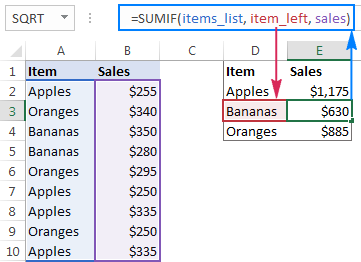
How to apply Excel names to existing formulas
If you've defined the ranges that are already used in your formulas, Excel won't change the references to the appropriate names automatically. Though, instead of replacing references with names by paw, you lot can have Excel do the work for you. Here'southward how:
- Select one or more than formula cells that yous want to update.
- Become to the Formulas tab > Ascertain Names grouping, and click Define Proper noun > Apply Names…

- In the Apply Names dialog box, click on the names you want applied, and so click OK. If Excel is able to match any of the existing names with the references used in your formulas, the names volition be selected for you automatically:
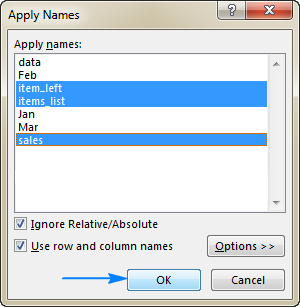
Additionally, two more than options are available (selected by default):
- Ignore Relative/Absolute - keep this box checked if you want Excel to apply just the names with the same reference type: supercede relative references with relative names and absolute references with absolute names.
- Use row and column names - if selected, Excel will rename all cell references that can be identified as the intersection of a named row and named cavalcade. For more than choices, click the Options
Excel proper name shortcuts
Equally is often the case in Excel, the nearly popular features can be accessed in several ways: via the ribbon, right-click menu, and keyboard shortcuts. Excel named ranges are no exception. Here are three useful shortcuts to work with names in Excel:
- Ctrl + F3 to open the Excel Name Manager.
- Ctrl + Shift + F3 to create named ranges from selection.
- F3 to go a list of all Excel names in a workbook.
Excel name errors (#REF and #Proper name)
Past default, Microsoft Excel does its best to keep your defined names consistent and valid past adjusting range references automatically when y'all insert or delete cells inside an existing named range. For instance, if you lot have created a named range for cells A1:A10, and so you insert a new row anywhere between rows 1 and 10, the range reference will change to A1:A11. Similarly, if you delete any cells betwixt A1 and A10, your named range will contract accordingly.
However, if yous delete all cells that make up an Excel named range, the proper noun becomes invalid and displays a #REF! mistake in the Name Managing director. The same error will bear witness up in a formula referencing that name:

If a formula refers to a non-existing name (mistyped or deleted), the #Name? error volition testify upward. In either case, open the Excel Name Manager and check the validity of your defined names (the fastest way is to filter names with errors).
This is how you create and apply names in Excel. I thank you for reading and hope to see y'all on our blog next week!
You may likewise exist interested in
Source: https://www.ablebits.com/office-addins-blog/2017/07/11/excel-name-named-range-define-use/
Posted by: paulifeackle.blogspot.com


0 Response to "How To Create Defined Names In Excel"
Post a Comment